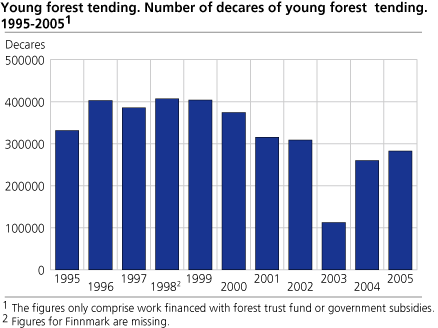Content
Published:
This is an archived release.
Low level of forest planting
Since the beginning of the 1990s there has been a gradually decrease in forest planting. In 2005 the planting was at a record low.Approximately 100 000 decares were planted, a decrease of 10 per cent from 2004.
From the 1980s and to the beginning to the 1990s around 300 000 decares were planted yearly. In 1994 the planted area was reduced to approximately 200 000 decares. In 2003 the disappearance of public subsidies increased the reduction. Approximately 100 000 decares were planted in 2005, only one third of the area planted in 1990, and a decrease of 10 per cent from 2004.
In addition to the removal of public subsidies, there are various reasons for this reduction. The roundwood removals reached a peak in the years around 1990 and dropped to a level between 7 and 9 million cubic metres in the following years. In 2004 a total of 7.4 million cubic metres of roundwood were cut for sale. The reduced roundwood removals have reduced the need for forest planting. In addition, natural regeneration has become more and more common. In 2005, NOK 73 million was invested in planting. The average cost per decare was NOK 634, plant cost and work included.
Investments in silviculture
Measured by invested amount, forest planting has been the most important single investment within silviculture. In 2005, the invested amount in tending of young stands exceeded the amount invested in planting. Totally, NOK 172 million were invested in silviculture in 2005. Government subsidies covered NOK 33.5 million and the forest owners paid the remaining NOK 138.5 million.
Except for forest planting, NOK 79 millions was invested in tending of young stands and NOK 20 millions in other purposes as scarification, fertilizing, drainage and so on.
More tending of young stands
From 2003 to 2004 the tended area increased with 150 000 decares. In 2004 the public subsidies were reintroduced, and thus represent the main reason for the increase. In total, 283 000 decares of young forest were tended in 2005, which is 22 900 decares more than in the previous year.
Less scarification
Scarification involves the removal of vegetation to improve the conditions for natural regeneration and growth of forest plants. A total of 49 600 decares were scarificated in 2005, a decrease of 8 100 decares from 2004. Nearly 50 per cent of the scarification was carried out in Hedmark.
Decline in drainage
There has been a sharp decline in the drainage of bogs and woodland in recent years. This is mainly due to greater environmental awareness and reduced public subsidies. In 2005, a total area of 1 627 decares of forest ground and bogs were drained, of which 1 575 decares were woodland and 52 decares were bogs. By comparision, 25 000 decares of woodland and 4 700 decares of bogs were drained in 1991.
Spraying
The use of chemical eradicants for cleaning and weed combating in forestry has dropped in recent years. In 2005 there is registered a slight increase in forest spraying. In total 7 000 decares were sprayed, 265 decares more than in 2004.
More fertilizing of forest
In 2005, a total of 9 200 decares of forest land were fertilized, representing an increase of 32 per cent from the year before.
Tables:
Contact
-
Terje Olav Rundtom
E-mail: terje.olav.rundtom@ssb.no
tel.: (+47) 91 38 60 61
-
Trond Amund Steinset
E-mail: trond.amund.steinset@ssb.no
tel.: (+47) 40 81 13 73


